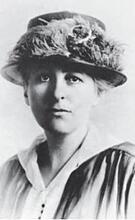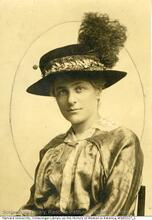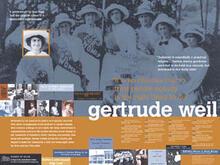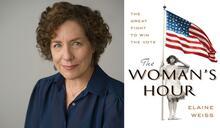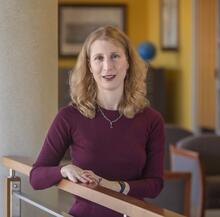Maud Nathan
Maud Nathan came from a distinguished Sephardic family. In 1880, at age seventeen, she married her thirty-five-year-old cousin and began the traditional role of society wife, but after her only child died in 1895, she focused on helping others to distract herself from her loss. Among her many commitments, she was vice president of the Woman’s Municipal League of New York and served as president of the New York Consumers League from 1897 to 1927. She believed that making consumers aware of workers’ suffering would put enough economic pressure on employers to force real reform. She also fought for women’s suffrage. In 1897 she became the first woman invited to speak at the Sephardic synagogue Shearith Israel. She also wrote two books, Story of an Epoch-Making Movement in 1926 and Once Upon a Time and Today in 1933.
Early Life and Family
Maud Nathan, social reformer and political activist, lived two distinct lives. She was born on October 20, 1862, into a distinguished old New York Sephardic family (she had relatives who fought in the American Revolution; one of her cousins was Supreme Court Justice Benjamin Cardozo; and another cousin was the poet emma lazarus) and had a privileged childhood. Her parents were Annie Augusta (Florance) and Robert Weeks Nathan. She had an older brother, Robert Florance Nathan, a younger brother, Harold Nathan, and a younger sister, annie nathan meyer, founder of Barnard College. The family moved to Green Bay, Wisconsin, for four years after her father suffered some business reversals, and Maud Nathan finished her high school education in the local public high school. The Nathan children returned to New York after their mother died in 1878. Two years later, at age seventeen, Maud Nathan married her thirty-five-year-old first cousin Frederick Nathan, and embarked upon the life of a society wife. She served various charitable causes and was, it was said, the life of every party she attended. She and her husband summered in Saratoga Springs, New York, where she was renowned for her beautiful singing voice and her elegant presence at all the glittery social functions.
Maud and Frederick Nathan had one child, Annette Florance Nathan, who died in 1895 at age eight (although Frances Nathan Wolff, Frederick Nathan’s sister, gives Annette’s age at the time of her death as ten in her Four Generations: My Life and Memories of New York over Eighty Years). Her daughter’s death brought about a dramatic change in Maud Nathan’s life.
Social Reform and Suffrage
A friend, Josephine Shaw Lowell, founder of the New York Consumers League, urged Nathan to take a greater interest in the sufferings of working women in New York City, ostensibly as a way to free herself from her grief over the loss of her child. This was the real beginning of Nathan’s distinguished career as a social reformer and political activist. Nathan was president of the New York Consumers League from 1897 to 1927. She served as vice president of the Woman’s Municipal League of New York. From 1902 to 1904, she chaired the industrial committee of the General Federation of Women’s Clubs. She was a member of the Daughters of the American Revolution. Her work was not limited to exposing bad working conditions for women and children but also focused on educating consumers. She argued that it was the consumer’s responsibility to be aware of conditions in factories and sweatshops, and also to strive to be a responsible shopper on a daily basis. At Christmastime, for example, hints to shoppers published in the New York newspapers included exhortations to shop early and to carry small packages home themselves rather than asking the shop to deliver them.
Nathan also worked tirelessly for woman suffrage, an issue that caused a rift in her relations with her family. Her brothers and sister opposed this reform, while her cousin Benjamin Cardozo supported a constitutional amendment, writing Nathan that his conscience would not allow him to vote against it.
Frederick Nathan shared his wife’s views on equal suffrage, leading the Men’s League for Equal Suffrage, helping to organize the International Men’s League at Stockholm, and marching in the first suffrage parade. Newspaper accounts of conventions and demonstrations often mention his presence at his wife’s side (occasionally referring to him as Mr. Maud Nathan).
Jewish Views
Nathan was the first woman invited to speak at the Sephardic synagogue Shearith Israel, giving a talk entitled “The Heart of Judaism” in 1897. Simon Nathan, Frederick Nathan’s great-grandfather, was president of Shearith Israel at one time, and the Nathan family was an important and powerful influence on the congregation. Maud Nathan called for Jews to abhor “racialism,” to be open-minded, and to work for social justice and reform. Her attitude toward members of her religion suggests an antipathy to religious dogma and a strong belief that religious faith is best exemplified by a commitment to social justice and tolerance of all people and faiths. Her writing was not limited to sermons, however. Maud Nathan won the New York Herald Prize in 1913 for the best letter in favor of woman suffrage. She wrote two books, Story of an Epoch-Making Movement (1926), on the Consumers League, and Once Upon a Time and Today (1933).
Later Life and Legacy
The collection of twelve scrapbooks housed at the Schlesinger Library of Radcliffe College, attests to Nathan’s astute marketing sense. She employed several clipping services, and thus was able to preserve a variety of letters to the editors of various newspapers, as well as accounts of demonstrations, lectures, marches, and honors. There are newspaper articles about a public meeting at which Nathan was heckled by an anti-suffragist ex-assemblyman and the furor that followed. There are accounts of speeches and lectures, almost all of which remark favorably on Nathan’s elegant appearance and imposing demeanor, and all of which convey a sense of a lively, interested, intelligent woman and the culture she inhabited.
After Frederick Nathan died in 1919, Maud Nathan and her companion, Corinne Johnson, traveled the world together, continuing to work for the rights of working women, equal suffrage, and the education of consumers. Nathan and Johnson bought a summer home in Litchfield, Connecticut, where they involved themselves in the community. They were instrumental in forming a community action group, and supported the local schools, presenting awards at graduation ceremonies for many years.
Maud Nathan died at home on December 15, 1946, at age eighty-four.
Selected Works by Maud Nathan
Once Upon a Time and Today (1933).
Scrapbooks. Schlesinger Library, Radcliffe College, Cambridge, Mass.
Story of an Epoch-Making Movement (1926).
AJYB 6 (1904–1905): 159–160, 24:185, 49:615.
BEOAJ.
DAB 4.
JE.
NAW.
Obituary. NYTimes, December 16, 1946, 23:3.
UJE.
Wolff, Frances Nathan. Four Generations: My Life and Memories of New York over Eighty Years (1939).
WWIAJ (1926, 1928, 1938).
WWWIA 2.


